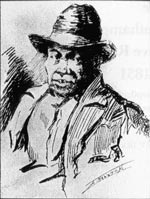Short Profile of Nat Turner, 1800 -1831
By Marsha Prescod
 Nat
Turner, 1800 -1831, was an African-American slave who
led the largest and most significant slave revolt in
United States history. He was, significantly, born
five days before the execution of the African American
slave Gabriel Prosser, leader of another famous slave
rebellion in Richmond, Virginia. Turner's father, also
a slave, successfully escaped and is believed to have
spent his life with other escaped African Americans,
as part of a fugitive group living in swamp lands.
(Slaves escaping to live in fugitive societies were
known as Maroons). His mother was born in Africa and
kidnapped and brought to the US in 1793. She taught
him he would be great. From both parents he acquired
a belief in freedom. He learned to read in boyhood
(often barred to slaves under threat of mutilation).
He became a Christian in his youth, became a preacher,
and had visions throughout his life. In 1821 he ran
away from his owners, and before he was captured had
a vision of leading a slave rebellion. For 5 years
from 1825 he preached to black congregations in Southampton
County, Virginia. Nat
Turner, 1800 -1831, was an African-American slave who
led the largest and most significant slave revolt in
United States history. He was, significantly, born
five days before the execution of the African American
slave Gabriel Prosser, leader of another famous slave
rebellion in Richmond, Virginia. Turner's father, also
a slave, successfully escaped and is believed to have
spent his life with other escaped African Americans,
as part of a fugitive group living in swamp lands.
(Slaves escaping to live in fugitive societies were
known as Maroons). His mother was born in Africa and
kidnapped and brought to the US in 1793. She taught
him he would be great. From both parents he acquired
a belief in freedom. He learned to read in boyhood
(often barred to slaves under threat of mutilation).
He became a Christian in his youth, became a preacher,
and had visions throughout his life. In 1821 he ran
away from his owners, and before he was captured had
a vision of leading a slave rebellion. For 5 years
from 1825 he preached to black congregations in Southampton
County, Virginia.
Traveling from church to church allowed Turner to gather
the knowledge he needed to organize his revolt, such
as road locations and hiding places. In 1831 he took
an eclipse of the sun as a signal that the time had come
for him to launch his slave rebellion. He convinced four
other slaves to join him, and they made plans to begin
the uprising on July 4.
Due to Turner falling ill the revolt started after midnight
on August 22. The uprising began at the Travis home,
where Turner was a slave, where the rebels killed everyone
in the household. Turner initially intended to move from
house to house urging other slaves to join the rebellion.
The plan was to get to Jerusalem, Virginia, the Southampton
County capital where there was an arsenal, that if captured
would allow the insurgents to arm themselves adequately.
As the band moved from house to house, more and slaves
joined the rebellion and when the local militia met them
it retreated. When the slave army stopped at
a place called James Parker's farm for fresh recruits and supplies, the militia,
which had regrouped, struck again. Turner attempted to rally his troops, who
were armed with knives, hatchet and axes, reinforcements for the militia arrived-
armed with guns - and killed over 100 rebels. Turner escaped, avoiding capture
for months until October 30. Nat Turner was tried, convicted, and sentenced to
death. He was hanged and skinned on November 11, 1831. His corpse was mutilated
and various body parts were kept by whites as souvenirs. While awaiting execution,
he told his story to his court-appointed lawyer, Thomas Gray. The result was
a book which Gray published as Nat Turner's Confessions. In the aftermath of
the rebellion, hundreds of blacks were tortured and murdered by hysterical mobs
in Virginia. A repressive policy against slaves and free blacks was instituted
in the state. Turner became a potent symbol to slaves throughout the South.
Additional links:
The
confessions of Nat Turner, the leader of the late insurrection
in Southampton, VA.: Electronic Edition
"as fully and voluntarily made to
Thomas R. Gray
in the prison where he was confined, and acknowledged by
him to be such when read before the court of Southampton;
with the certificate, under seal of
the court convened at Jerusalem,
Nov. 5, 1831, for his trial.
Also, an authentic
account of the whole insurrection,
with lists of the whites who were murdered,
and of the negroes brought before the court of
Southhampton, and there sentenced, &c.
Baltimore:
Published by Thomas R. Gray.
Lucas & Deaver, print.
1831.", "... SIR,--You have asked me to give a history of the motives
which induced me to undertake the late insurrection, as you call it--To do so
I must go back to the days of my infancy, and even before I was born...."
|




